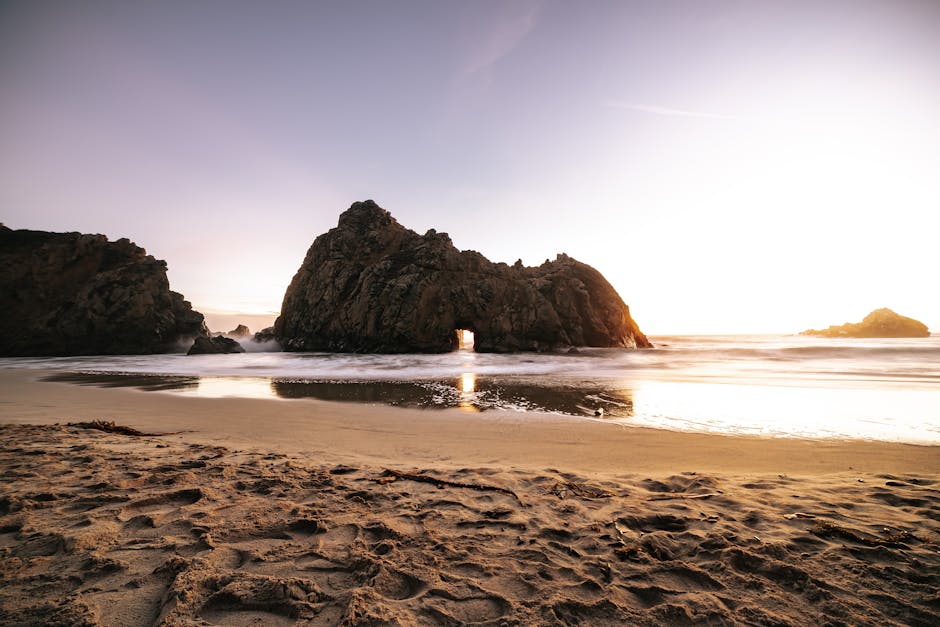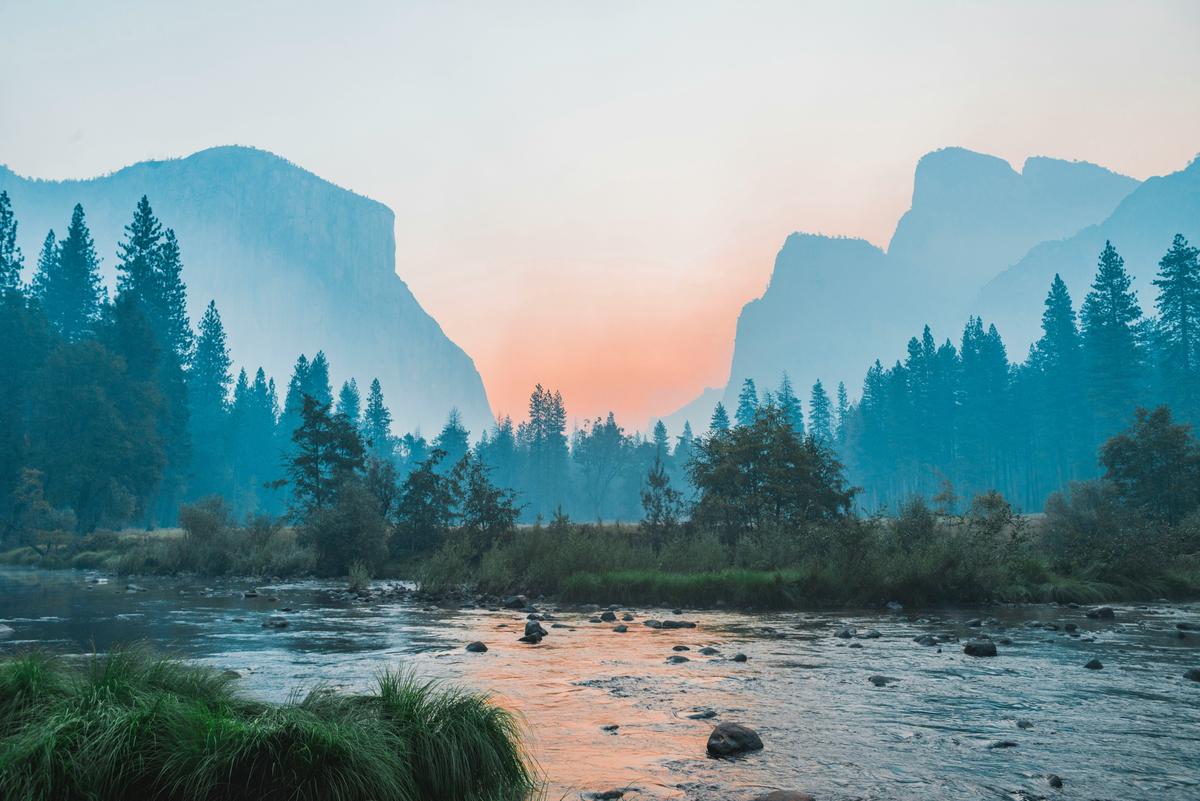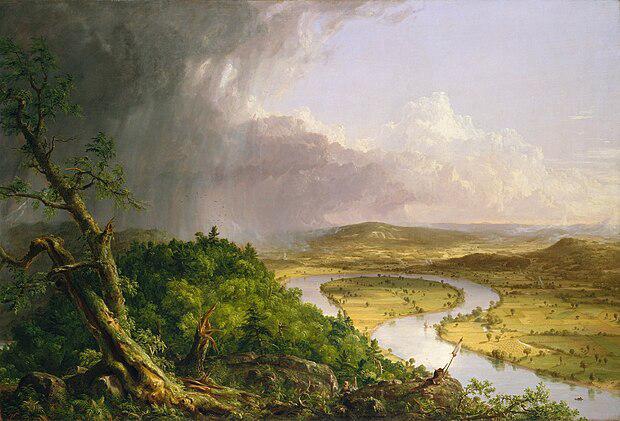Key Artists and Their Contributions
Thomas Cole, the vanguard of the Hudson River School, brought to life some of the grandest and most evocative landscapes of early American art. His pieces embodied a narrative, a reflection of existential musings set against the untamed beauty of the wilderness. Look no further than "The Course of Empire." This series of five paintings illustrates the rise and fall of a civilization, each canvas a chapter that intertwines both awe and caution. Through "The Savage State" to "Desolation," Cole's mastery in allegory is palpable, urging viewers to perceive nature's magnificence and fragility.
Asher B. Durand, while a contemporary and admirer of Cole, carved his own niche within the movement, steering the Hudson River School towards a more naturalistic depiction of the American landscape. His "Kindred Spirits" remains a poignant tribute to Cole and their shared vision. Set within the pristinity of the Catskills, it epitomizes the spiritual communion that Durand felt nature could evoke. Unlike Cole's more dramatic flair, Durand's depictions exuded serenity and intimacy, often spotlighting the more delicate interplay of light within woodland scenes.
Frederic Edwin Church, Cole's most notable disciple, took the ethos of the Hudson River School and pushed its boundaries—both geographically and artistically. Journeying far beyond the Hudson Valley, Church ventured into South America, painting works like "Heart of the Andes," a canvas so vast and detailed that it seemed to capture the very soul of the mountains. His technical prowess, married with a daring sense of exploration, made his works emblematic of the school's ambitions. Church's landscapes, whether domestic like "Niagara" or foreign like "Cotopaxi," were spectacles, drawing crowds who marveled at his ability to encapsulate nature's grandeur and might.
Albert Bierstadt, with his colossal depictions of the American West, expanded the Hudson River School's influence even further. His works, such as "The Rocky Mountains, Lander's Peak," showcased a sublime interpretation of the wilderness, conveying an almost otherworldly sense of scale and drama. Bierstadt's paintings were not just visually arresting; they were theatrical, often employing dramatic lighting and meticulous detail to evoke powerful emotional responses. His canvases served as visual ambassadors of Manifest Destiny, depicting the West as a land of endless promise and majestic unpredictability.

Themes and Techniques
One of the most captivating aspects of the Hudson River School lies in its thematic richness. The artists employed their canvases not merely to represent the American landscape but to idealize it, offering viewers a vision of nature imbued with almost divine purity and grandeur. The landscapes are often portrayed as untouched, Edenic environments, conveying a sense of primordial beauty and tranquility that predated industrial encroachment.
This idealization went hand-in-hand with a profound contrast between wilderness and civilization, often depicted in staggering clarity. Take, for example, Cole's "The Oxbow," where the left side of the canvas is enveloped in the wild, untamed forest, darkened by a recent storm, while the right side bathes in sunlight, showcasing cultivated farmland. This juxtaposition carried deeper messages about the trajectory of human progress and its impact on the natural world.
Allegory was a frequent device used to foreground these deeper themes. Cole's "Course of Empire" series is exemplary, narrating the cyclical rise and fall of civilizations through a sequence of landscapes that transition from the untouched wilderness to the ruins of a once-great empire. Each painting serves as both a standalone masterpiece and a chapter in a broader narrative about human ambition and its impermanence.
The techniques employed were as meticulous and thoughtful as their themes. A hallmark is the masterful use of light, particularly the dramatic interplay between light and shadow. The luminism present in many works—an emphasis on soft, diffused light that illuminates vast stretches of landscape—reinforced the spiritual and tranquil qualities of these scenes.
Their approach to composition was equally deliberate. Hudson River School artists often arranged elements to guide the viewer's eye through the landscape, whether towards a distant mountain range or a serene river bend. This compositional technique often resulted in panoramic views that could be almost cinematic in scope, encouraging a deeper engagement with the scene.
Realism was another cornerstone of their technique, albeit tempered with Romantic idealism. While their landscapes were rooted in real geographical locations, they often idealized these settings, incorporating elements that enhanced their grandeur or tranquility. Frederic Edwin Church's "Heart of the Andes" exemplifies this blend, capturing the Ecuadorian mountainscape with astonishing accuracy while imbuing the scene with an almost otherworldly serenity.
These thematic and technical elements offered a vision of what America could represent. The detailed realism provided authenticity, while the idealization and allegorical elements forged a unique narrative of American identity and promise. Each technique, each thematic exploration, added layers of meaning, making the landscapes more than mere studies in scenery. They became dialogues between man and nature, past and future, reality and ideal, inviting viewers to immerse themselves in the boundless beauty and complexity of the American terrain.
Influence and Legacy
The Hudson River School's influence extended far beyond its founding artists. This movement sowed the seeds for subsequent American art movements like Luminism and American Impressionism. The luminous techniques, characterized by delicate treatment of light and intricate detail, found echoes in Luminism. Artists like Fitz Henry Lane and John Frederick Kensett evolved into prominent Luminists, depicting serene water scenes with a striking emphasis on light and atmosphere.
The Luminist painters adopted a subtler approach, focusing on tranquil, almost poetic interpretations of nature, capturing the stillness and reflective qualities of water and sky. This evolution marked a shift towards a more intimate and contemplative view of the American landscape, yet it retained the spiritual and emotional depth of the Hudson River School.
American Impressionism, too, owes a debt to the foundational works of the Hudson River School. While influenced by French Impressionists, the American ethos of landscape painting laid by the Hudson River School continued to resonate. The dedication to capturing light and daily scenes can be seen as an extension of the detailed realism combined with Romantic idealism that characterized the Hudson River School.
The emphasis on plein air painting persisted into the American Impressionist movement, allowing artists to play with natural light and create dynamic compositions. This continuity highlights the enduring influence of the Hudson River School's commitment to authenticity and immediacy in depicting the American landscape.
Beyond its technical contributions, the Hudson River School fostered a sense of national identity. Through their works, artists celebrated the unique beauty and vastness of the American wilderness, offering viewers a source of national pride and a shared cultural touchstone. Their depictions presented the American landscape as a new Eden, an untouched paradise that contrasted with the industrialized landscapes of Europe.
Their art promoted a burgeoning national identity grounded in the grandeur and promise of the American hinterland. The reverence for pristine nature depicted in these paintings inspired an early appreciation for conservation, rooted in the ideal of nature's untamed grandeur. Figures like John Muir were influenced by the extraordinary beauty captured in these works, laying the philosophical groundwork for the establishment of the National Park Service in 1916.
In summation, the Hudson River School's influence is profound. It bridged the gap between earlier American landscape painting and later movements. It helped shape the narrative of American identity, portraying the landscape as both a source of national pride and a spiritual sanctuary. Moreover, the reverence for nature encapsulated paved the way for the early conservation movement, highlighting the school's enduring legacy in both the artistic and environmental spheres.

Notable Works and Their Significance
Among the Hudson River School's masterpieces, a few notable works stand out for their artistic brilliance and cultural impact.
Thomas Cole's "The Oxbow" encapsulates his dualistic view of nature and civilization. The wild, storm-ravaged landscape contrasts with a serene, cultivated scene, symbolically bridging the gap between the untamed and the controlled. This allegory reflects the broader themes of expansion and industrialization that permeated 19th-century America.
Frederic Edwin Church's "Niagara" captures the power and sublime beauty of the natural world. The panoramic view of Niagara Falls invites viewers to immerse themselves in the roaring waters and misty air. This work reinforces the Hudson River School's ability to captivate public imagination and instill national pride.
Albert Bierstadt's "The Rocky Mountains, Lander's Peak" embodies the sheer expanse and majesty of the American West. The monumental scale underscores the awe-inspiring power of the landscape, evoking a sense of infinite possibility and adventure. This painting carries the imprint of Manifest Destiny, illustrating the untamed wilderness that American settlers viewed as their future.
Asher B. Durand's "Kindred Spirits" transcends its idyllic scenery to symbolize the mutual influences between art, literature, and nature in fostering a uniquely American cultural identity. Its poignancy captures the essence of the Hudson River School's philosophy: nature as a spiritual and intellectual sanctuary.
Frederic Church's "Heart of the Andes" is a blend of scientific precision and romantic idealism, capturing the complex ecosystem of the Andean mountains. It combines the precise documentation of varied flora with the overarching beauty of the vast terrain, making it an enduring symbol of the Hudson River School's international aspirations.
John Frederick Kensett's "Eaton's Neck, Long Island" marks a subtle shift towards Luminism while maintaining the core principles of the Hudson River School. Kensett's mastery in rendering light and atmosphere transforms the ordinary into the extraordinary, offering a contemplative pause in the grand narrative of American expansion and industrial progress.
These iconic works encapsulate the Hudson River School's core principles and broader cultural significance. They are profound commentaries on nature, civilization, and the American experience. Each canvas invites viewers to appreciate the splendor of the natural world, urging a harmonious coexistence with the environment, which remains a powerful and relevant message today.

Photo by baileyzindel on Unsplash
Historic Sites and Museums
Begin your journey at the Thomas Cole National Historic Site in Catskill, New York. This preserved home and studio of Thomas Cole, the founder of the Hudson River School, stands as a testament to his influence on American art. As you walk through Cedar Grove, you'll find yourself surrounded by the landscapes that inspired Cole's masterpieces. The site offers guided tours that delve into Cole's life, his artistic process, and his appreciation for nature. Don't miss the rooms filled with Cole's original works, period furnishings, and personal artifacts.
One of the profound experiences is the Hudson River School Art Trail. This trail connects spots where Cole and his contemporaries painted. Hikers can traverse through North-South Lake, Kaaterskill Falls, and more, witnessing firsthand the vistas that stirred the souls of these early American landscape painters.
Across the river lies the Olana State Historic Site in Hudson, New York, the residence of Frederic Edwin Church. This Persian-inspired villa, designed by Church himself, offers panoramic views of the Hudson River Valley—a scenery that inspired many of his later works. Visitors can tour the mansion, which houses Church's paintings, sketches, and artifacts from his travels.
The carefully designed grounds of Olana, spanning over 250 acres, are as much a part of the visit as the house itself. Wander through the gardens and trails that Church crafted to frame breathtaking views. The on-site exhibitions explore Church's life and his approach to capturing the sublime beauty of the Americas.
Another location is the Jasper Cropsey Home and Studio in Hastings-on-Hudson. This historic house, known as Ever Rest, has been preserved to reflect its 19th-century grandeur. The Gothic Revival-style villa provides insight into Cropsey's domestic life and features the artist's works and personal artifacts. The adjoining Gallery of Art showcases the Newington-Cropsey Foundation's collection, offering an extensive look at Cropsey's contributions to the Hudson River School.
For a broader exploration, consider visiting these institutions:
- The Frances Lehman Loeb Art Center at Vassar College
- The Samuel Dorsky Museum of Art at SUNY New Paltz
Both present well-rounded exhibitions and collections of the Hudson River School and its influences.
Finally, the Edward Hopper House Museum & Study Center offers a unique perspective, showcasing Hopper's early sketches and the influence of his Hudson River predecessors.
These historic sites and museums safeguard the heritage of the Hudson River School and cultivate reverence for the landscapes that these artists passionately depicted. Through these visits, one can grasp the depth of the Hudson River School's impact and its resonance in the American spirit.






















